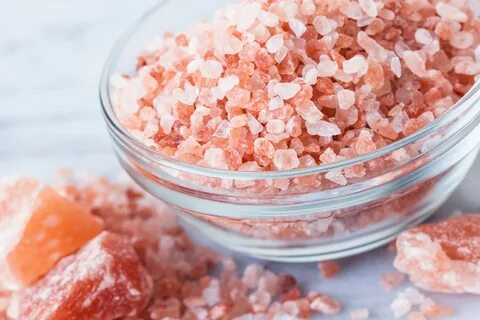What is Salt and Pink Himalayan Salt?
Where You Can Use Pink Himalayan Salt?
Pink
Himalayan salt is a kind of salt that's natural pink in hue and is mined close
to the Himalayas in Pakistan.
Many
people believe that it's rich in minerals, and offers extraordinary health
benefits.
Because
of this, pink Himalayan salt is believed to be healthier than regular table
salt.
But,
very little study on pink Himalayan salt is available, however, while others
believe that these outrageous claims of health benefits are just speculation.
This article focuses on the major distinctions between Himalayan pink salt and regular salt, and then evaluates the evidence to determine which kind of salt is more beneficial.
What Is Salt?
The
mineral salt is comprised of the chemical sodium chloride.
Salt
is so full of sodium chloride -- approximately 98% by weight the majority of
people are using the terms "salt" and "sodium" in
conjunction.
Salt
can be made through the process of evaporating salt water, or by extracting solid
salt from salt mines underground.
Before
it is delivered to your supermarket table salt goes through a refining process
in order to get rid of impurities as well as any other minerals other than
sodium chloride.
Anticaking
agents can be used to absorb water, and iodine is frequently added to aid
consumers in preventing the deficiency of iodine.
Salt
has been used by humans to flavour food and preserve it for hundreds of years.
In
addition, sodium is a key player in various biological functions which include
the balance of fluids as well as nerve conduction and muscle contraction
This
is why it's essential to include sodium or salt in your food.
But,
many health experts assert that excessive sodium may cause the development of
high blood pressure as well as heart diseases, however, recent research has put
this long-held belief in question.
In
light of the possible risks of eating excess table salt, many are turning to
pink Himalayan salt as they believe it is an alternative that is healthier.
What Is Pink Himalayan Salt?
Pink
Himalayan salt is a pink-coloured salt that was extracted from Khewra Salt Mine
that is located close to the Himalayas in Pakistan.
It
is believed that the Khewra Salt Mine is considered to be one of the oldest and
biggest salt mines in the world.
Pink
Himalayan salt extracted from this mine is believed to have formed thousands of
years ago through the process of evaporation from old bodies of water.
The
salt is extracted manually and processed minimally to create an unrefined
product without additives and is believed to be more natural than table salt.
Astable salt Pink Himalayan salt is mostly composed of sodium chloride.
But
the process of harvesting natural permits the pink Himalayan salt to have
numerous other minerals and trace elements that aren't present in table salt.
It
is believed to include up to 84 different mineral elements and trace
elements. Actually it's precisely these minerals, specifically iron that
make it the distinctive pink hue.
How Is Pink Himalayan Salt Used?
Pink
Himalayan salt is used for a variety of dietary and non-dietary applications.
You may eat it or use it in your cooking
In
general, you can cook using pink Himalayan salt the same way as you would use
regular table salt. Use it in marinades and sauces, or sprinkle it on your
dinner table.
Many
people utilize pink Himalayan salt for cooking on a surface. The salt in
large blocks can be bought and used to sear, grill or give a salty taste to
other food items and meats.
Pink
Himalayan salt can be bought in finely ground form, just like normal table
salt, however, it is common to find coarse salt available in larger sizes of
crystals.
Considerations for Cooking
It
is critical to consider the condition of the ground when measuring any type of
salt in volume.
It
is possible that you will need to use more coarse salt in order to meet how
salty finely ground salt is. This is due to the fact that finely-ground
salt is packed more tightly in comparison to coarse salt which means you'll
find more in a specific amount.
For
instance, 1 teaspoon that is finely ground could have around 2,300 mg of sodium.
While the amount of coarse salt could differ based on the size of the crystal
but may contain less than 2,000 mg sodium.
Additionally, the pink Himalayan salt is slightly lower in sodium chloride than table salt.
This is something you might have to take into account when cooking.
The
current dietary guidelines for the US advise that the majority of adults should
consume less than 2,300 mg sodium a day. This is equivalent to 1-tsp (6
grams) of finely ground salt.
If
it comes to pink Himalayan salt, be sure to verify the nutritional label because the sodium content can differ widely, based
on the type of salt used.
Non-Dietary Uses
Although
pink Himalayan salt has numerous culinary uses it also has numerous
non-food-related uses.
Pink
Himalayan salt is often used in bath salts that promise to help with skin
issues and aching muscles.
Salt
lamps are often made from pink Himalayan salt and are claimed to get rid of
air pollution. They are made up of huge chunks of salt that have an
internal light source that is used to heat the salt.
In
addition, taking a trip to man-made salt caves that are made from Pink
Himalayan salt is very popular with those who want to treat conditions of the
respiratory system and skin.
However,
the research that supports the three non-dietary benefits of Pink Himalayan
salt is rather insufficient. Further studies are required.




Comments
Post a Comment